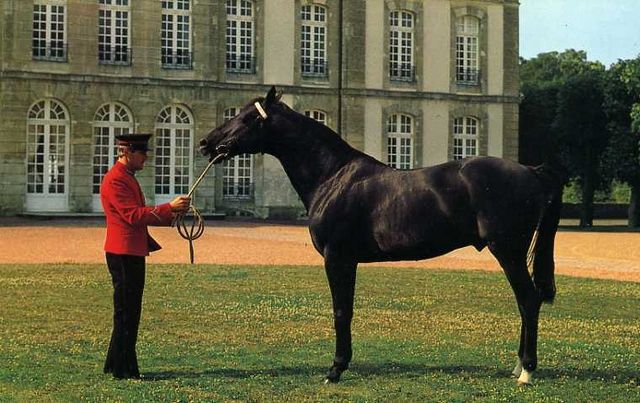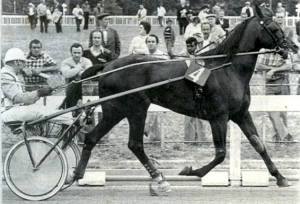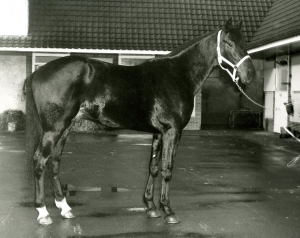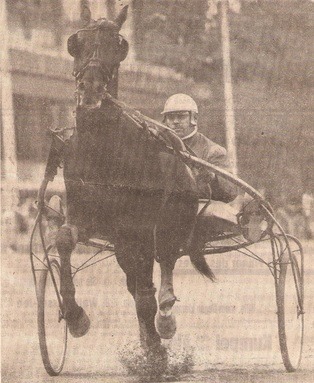Florestan
by Lisa Harkema
When Roquepine ruled the trotting world in the mid to late 60s, a few voices called for the opening of the French studbook. This had been closed since 1937, so foreign stallions or mare who weren’t already approved by then could never have their foals admitted to the French studbook (and thus be eligible to the money-rich French races). All such appeals were immediately turned down by the French association and their powerful and president Rene Balliere, whose nationalist opinions of non-French trotters were inches short of demanding they be shot on sight. Despite this characterization, Balliere was also a visionary (e.g. Grosbois became a trotting heaven under his guidance) and a fantastic president for the French association – but seeing anything good in foreign trotters wasn’t his strong side. When Elaine Rodney and a few other foreigners posed a strong threat to French trotting queen Ozo for the 1965 Prix d’Amerique, they simply changed the race rules in Ozo’s favor. They even got the US-bred but Italian-owned Firestar thrown out of the race for good measure.
Henri Levesque, Roquepine’s owner, was one of those more cosmopolitan people. He had traveled widely (with Roquepine) and seen the American trotter. He firmly believed in the Franco-American cross. So when Levesque in 1970 decided to breed his supreme mare to the best stallion in the US, Star’s Pride, it created big waves. Breeding Roquepine to Star’s Pride was Levesque’s silent protest but the calls for Florestan to be admitted to the French studbook upon his birth fell on deaf ears. The French association was crystal clear that it would never happen. But as history always show: pride comes before a fall. In this case the fall turned out to be both mighty humbling.
The dark brown foal Florestan was born at Hanover Shoe Farms on April 19, 1971 (for some reason many in Europe still think he was born in France but he is most certainly not). Roquepine and her colt flew to Europe in late 1971 after she had been bred to Ayres (a mating which produced the very good Granit born 1972). Levesque initially had the idea that Florestan could be flown back to the US at 3 to compete in the Hambletonian and a few other races but eventually he abandoned the idea. Trained by German trainer Gerhard Kruger and groomed by Klaus Kern, Florestan was primarily stabled in Roma. He was a massive talent but his background became his undoing. Back then in Europe, age-specific races were only open to domestic-born horses. Florestan was most certainly not welcome in races for French 3-year-olds and despite being trained in Italy he was not welcome in races for 3-year-olds in Italy either (since he wasn’t Italian-born). Competing for Scuderia Europa, he really only had one option open to him: to go against aged horses immediately – and often very good aged horses, too. To top it off, foreign horses were back then often (usually) given at least a 20 meter handicap intended to aid domestic trotters. For an unstarted 3-year-old it was a massive challenge and one would almost certainly expect an inexperienced young horse to buckle under the pressure.
But as always, the brilliant Krüger knew what to do. Levesque had after all hand-picked him to train Florestan (and his brother Granit) because of his excellence. The diminutive German was established as one of the best trainers in Europe. He had won his first race in Berlin at the tender age of 15 in 1940 before being forced (since he did not share his governments political views) to fight for the Wehrmacht in 1943. There he ended up as a Soviet prisoner of war in Auschwitz before, fortunately for German trotting, a serious leg injury caused him to be released early. Krüger eventually won more than 4000 races all over the world and was champion trainer on numerous occasions in Europe. He had worked with top French trainer Jonel Chyriacos, Henri Levesque, spent stints in the US and was even welcome in East-Germany to help out harness racing there after the Wall had been built. Then in 1964 he accepted an offer from the Santi brothers in Italy to become a trainer in the country of pasta. He trained many Italian imports from the US, most notably the fantastic Elaine Rodney.
Krüger gave Florestan plenty of time to develop slowly and did not stress him at 3. (The few international races in France and Germany where he could have started were closed to three-year-olds, anyway.) Late that summer (of 1974) he sent him to Fritz Sauer at the Krieau track in Vienna. He prepared Florestan and on October 5, 1974 he made his debut by winning the Großer Dukaten Preis at the Krieau track. The winning time of 1:22.6/2420 meters (2:13 over almost exactly 1 1/2 mile) doesn’t sound impressive but was a good time for a European 3-year-old back in 1974. What many don’t know is that Florestan actually raced twice that day! In Austria you didn’t need to qualify except to race at Krieau (and the qualifying requirement was 1:35km/2:32mr so not exactly demanding). For some reason Krüger and Sauer hadn’t bothered to qualify Florestan prior to raceday so he simply ran the qualifier in the morning and then the actual race at night. Against aged opposition Florestan won easily. After the race Krüger, one of the three «German musketeers» (Charlie Mills and Johannes Frömming were the other two), was lyrical and declared Florestan the best horse he had ever trained and driven. Eight days later Florestan underlined that claim by winning the prestiguous Hunyady race. Though he didn’t meet the best aged trotters in Europe he still had to take on some decent aged horses and the three-year-old again proved superior. After another easy win a month later the Austrians had had enough of his winning ways and on November 23 he was excluded from the betting – quite unheard of for an inexperienced 3-year-old going against aged opposition! Needless to say, Florestan won again. Roquepine and Florestan is the only mother-son combo to both have been placed outside of the betting in harness history.
After four wins in as many starts at 3, Krüger felt Florestan was well-prepared for the future but he was still intending to carefully select his races. Although he couldn’t keep the winning streak going he still acquitted himself nicely, winning the Greyhound-Rennen in Mönchengladbach (Germany), the Charlie Mills-Memorial in Berlin and the Grosser Preis von Bild (then called the Preis der Schnellsten) in Gelsenkirchen (Germany). Florestan had some strength but nowhere near the level of his dam. He had, however, inherited an insane burst of speed – presumably from the American genes of his paternal side. Tom Charters, who groomed Delmonica Hanover and had the opportunity to see him up close and in person never forgot him as he recalled that Delmonica «raced against Florestan in Munich. Could leave the gate faster than any trotter I ever saw at the point in my life. And for the next 40 years… Until Sebastian K.» These are the words of a former Hambletonian Society president who has seen a fair share of speedy horses in the Hambletonian and other races throughout the years, yet he still remembers Florestan’s exceptional speed burst in this fashion. (Separately, Sebastian K’s extreme speed comes from his French sire Korean who most likely got got it from … you guessed it, his damsiresire Florestan).
In 1976 the five-year-old Florestan travelled to France and finished third in the Prix de Washington (behind elite mare Clissa and Epigramme) and later that fall he won an elimination to the Prijs der Giganten at Hilversum in Holland. He had to bow three mares in the final, however, as he finished fourth behind behind Speedy Volita, Dauga and Clissa. That year he also won the Grosser Preis von Niederbayern in Munich ahead of his brother Granit (by Ayres as mentioned above). At the end of that year he stood at Konrad Wagner in Munchen/Munich when disaster struck. Florestan and another colt got loose and fought almost all night. When the stablehands arrived in the morning they found two injured (fortunately no life-threatening injuries) horses who had worn themselves out during the night. Although he would be able to return to the track at some point, the 1977 winter meeting was now out of the question and the decision was taken to retire him to stud. At 5, Florestan still was lightly raced and had «only» earned 255 761 FF (€38 761, close to $50 000) and a record of 1:15/2:00.3. Levesque’s only question was: where should he retire Florestan to stud? He had some nice wins though still a somewhat limited racing career. However, his pedigree ensured he would be welcomed with open arms in every European country.
Sometimes things take funny turns and one such turn happened in late 1976. The French national stud, the Haras du Pin, was technically there to comply with the wishes of the state and to work to strengthen «the French race.» Yet, the administration had considerably autonomy and could, in reality, dictate much on breeding matters. So when the key people at the Haras du Pin decided that «we cannot let Roquepine’s son stand stud in another country», they asked that the French studbook rules be changed to accomodate for Florestan’s inclusion. Sure, Levesque had broken the rules and pissed off the brass in the French federation – but the idea of Roquepine’s son standing in Germany or Italy – France’s rivals – was as heretic as surrendering in 1940 or selling the Eiffel Tower to the British. Back then, pedigree mattered (more then performances) to quite a few and any French-born son of Roquepine would automatically be approved for stallion duty – probably even if he was unable to cleanly trot a single step. So one phone call seemingly fixed the whole issue of a studbook closed for 40 years, Haras du Pin approached Levesque: would he sell Florestan for 750 000 French Francs (roughly €120 000/$150 000)? Henri Levesque immediately accepted, though there was probably more money to be had by standing him abroad. Florestan stood stud at the Haras du Pin from 1977. The Haras du Pin would use this influence and pull to their advantage on five occasions (Florestan, Granit, Kimberland, Mickey Viking and Workaholic).
Florestan is by many considered one of the more influential stallions in European history. The simple fact of the matter is that he is the most influential, period. The French trotter in the 1970s was not a well-bred, specialized and homogeneous breed like the US standardbred, which had been pure-bred for much longer. There were some very good French trotters but on the whole the breed lacked speed (though had strength in abundance), was often very powerfully built, had a reputation for often having challenging tempers (or being downright mean) and, in particular, for being bad-, poor- or, at best, funky-gaited. The French trotter of today cannot be compared to the French trotter for 40 years ago. Today the French trotter has plenty of raw speed and nobody complains about a poor gait. Although he is not solely responsible for this big change, Florestan started the revolution. He and his foals also revolutionized the thinking of breeders and trainers in France. At the Haras du Pin, Florestan unfortunately got a reputation for having quite a bad temper. His groom Klaus Kern is adamant that Florestan was a nice and well-mannered horse during his racing career so it is quite likely that Florestan’s temper took at turn for the worst after he was retired to stud.
When Florestan started at Haras du Pin there was quite a bit of interest in his services and he was limited to 60 mares per year. When the first crop hit the racetracks, interest exploded and some years there were more than 2000 applicants – for 60 spots! The numbers reveal so clearly why this happened. Florestan was, quite simply, a whole different animal and in a different class. Even though he only only had 624 French foals, 494 started. This is a starting percentage of 79,17 % – high by French standards even today and way above other stallions back then. If you wanted a foal that raced, breeding to Florestan was by far your best bet. Moreover, 68 foals earned more than €100 000 ($120 000 and change), that’s 10,90 % – a percentage most stallions today don’t come close to – and this in a time when purses where considerably lower than today. He didn’t produce any superstars but nice solid trotters, generally more medium-sized, who would trot cleanly and efficiently. He produced such good horses as (alphabetically) Baccarat du Pont, Opus Dei, Passionnant, Podosis, Pythagoras, Quito de Talonay, Québir de Chenu, Tonnerre d’Amour etc. His son Podosis was French champion stallion for several years and several other sons were both excellent trotters and influential stallions such as Quito de Talonay, Passionnant and Baccarat du Pont. 56 sons stood stud and these sons combined produced more than 16000 foals… Florestan is occasionally found as the only US influence in some otherwise-French-pedigreed stars such as Rapide Lebel and Univers de Pan. The latter two are horses with exceptional burst of speed. Florestan’s influence in Korean – and his son Sebastian K – was mentioned above. Add to that the fact that Ready Cash, another horse with both strength and exceptional speed, is linebred on Florestan (and only him). The influence of Florestan is immense and eternal.
Picture 1, 2 and 3: Training prior to, warm-up and celebrating the Hunyady win in Vienna in 1974.
Picture 4: Florestan at Haras du Pin
Picture 5:. Florestan at 2. Originally posted by Björn Hammarström. Picture by Einar Andersson.




